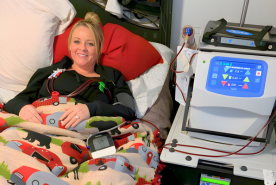There are 3 main types of dialysis: in-center hemodialysis, home hemodialysis, and peritoneal dialysis. Learn the pros and cons of each treatment.
Choosing Dialysis: Which type is right for me?
There are 3 main types of dialysis: in-center hemodialysis, home hemodialysis, and peritoneal dialysis. Each type has pros and cons. It’s important to remember that even once you choose a type of dialysis, you always have the option to change, so you don't have to feel "locked in" to any one type of dialysis. There may be medical, health, or lifestyle reasons why a certain type of dialysis is not right for you. Be sure to learn about each type and speak to your healthcare professional to find out what is right for you. The charts below will help you to compare some of the pros and cons of the different types of dialysis.
Dialysis
Sign up for a deep dive into dialysis
Learn about the different types of dialysis, receive additional resources, and learn so much more.
Table: Types of Dialysis
Peritoneal Dialysis | |
Advantages | Disadvantages |
|
|
Home Hemodialysis | |
Advantages | Disadvantages |
|
|
In-Center Hemodialysis | |
Advantages | Disadvantages |
|
|









